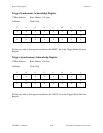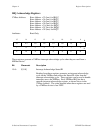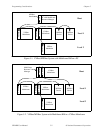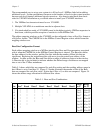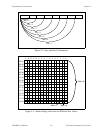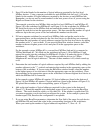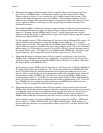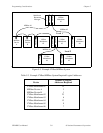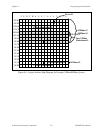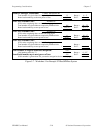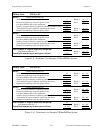Programming Considerations Chapter 5
VXI-MXI User Manual 5-6 © National Instruments Corporation
3. Next, fill in the blanks for the number of logical addresses required by the first-level
MXIbus devices. Using a separate worksheet for each MXIbus link on Level 1, fill in the
blanks for the number of logical addresses required by the devices on each MXIbus link.
Remember, you do not need to round numbers to the next power of two if you are using the
High/Low format for the windows.
The example system has two MXIbus links on the first level: MXIbus #1 and MXIbus #2.
Figure 5-8 is the worksheet for MXIbus #1 and Figure 5-9 is the worksheet for MXIbus #2.
We listed the devices on the MXIbus link and entered the number of logical addresses
required by each device into the appropriate spaces. We then rounded the number of logical
addresses up to the next power of two and entered this number into the table.
4. Fill out a separate worksheet for second-level MXIbus links and put the results in the
appropriate places on the worksheet for the first-level device to which they are connected.
Determine the total number of logical addresses required for the first-level device by adding
the numbers with "+" next to them. If you are using Base/Size window formats, round this
number to the next highest power of two and place it in the appropriate space on the
worksheet.
For the example system, MXIbus #3 is a second-level MXIbus link and it is connected to
VXIbus Mainframe #3. We filled out the worksheet in Figure 5-10 for MXIbus #3 and
entered the results into the worksheet for MXIbus #1 (Figure 5-8) under the device VXIbus
Mainframe #3. MXIbus #3 needs 32 logical addresses and the devices in VXIbus
Mainframe #3 need 6 logical addresses. The sum of these numbers is 40, which rounds up
to 64.
5. Determine the total number of logical addresses required by each MXIbus link by adding the
numbers adjacent to the "*" symbols and entering that number in the appropriate space at the
bottom of the worksheet. If you are using the Base/Size window format, round the number
to the highest power of two and enter it into the appropriate space on the worksheet. Place
these numbers in the appropriate spaces on the worksheet for the next highest-level device to
which the MXIbus link is connected.
In the example system, MXIbus #1 requires 101 logical addresses (found at the bottom of
Figure 5-8) and MXIbus #2 requires 8 logical addresses (found at the bottom of Figure 5-9).
We placed these numbers in the corresponding spaces in Figure 5-7.
6. Add up the total number of logical addresses required for the system (at the bottom of
Figure 5-7). Round this number up to the highest power of two if you are using Base/Size
formats. The result should be equal to or less than 256. If the number is greater than 256,
you must reorganize your devices and reconfigure the system. In the example system, this
number equals 256, therefore the configuration is acceptable.
7. If you are using Base/Size parameters, determine the Size field of the range for each device
and MXIbus link and insert that value in the corresponding locations of the worksheets.
When you round up the number of logical addresses required to 2
x
,
Size = 8 – X.




